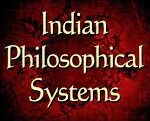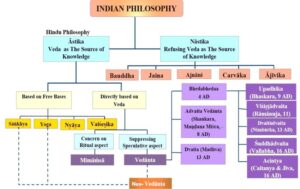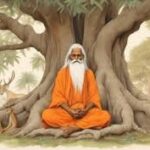Hello, young philosophers! Have you ever looked at the world around you and wondered who created it, and who controls it? You see the sun, the moon, the stars, and so many beautiful things on Earth. You feel the hot summer, the cool winter, and the refreshing rain. You watch people grow up and sometimes, sadly, pass away. These big questions have puzzled humans for a very long time. The study of these questions is called Darśana (Philosophy). In this blogpost, we will see Indian Philosophical Systems.

In Indian philosophical Systems, there are two important concepts to understand: Prameya (objects of knowledge) and Pramāṇa (means of knowledge or sources of knowledge). Let’s explore them together!
The Six Ways of Knowing (Pramāṇas):
- Pratyakṣa (प्रत्यक्ष) – Direct Perception: This is the knowledge we get through our senses. For example, seeing a rainbow or hearing a bird sing.
- Anumāna (अनुमान) – Inference: This is when we make conclusions based on evidence and reasoning. Like seeing smoke and inferring there’s fire.
- Upamāna (उपमान) – Analogy: Learning by comparing things. For instance, understanding what a lion is by comparing it to a tiger.
- Śabda (शब्द) – Verbal Testimony: Knowledge gained from words, especially from trustworthy sources, like books or teachers.
- Anupalabdhi (अनुपलब्धि) – Non-perception: Understanding something by the absence of evidence, like knowing a room is empty because you see no one in it.
- Arthāpatti (अर्थापत्ति) – Implication: Assuming something because it explains the situation best, like knowing someone is fasting because they haven’t eaten all day.
 Indian Philosophical Schools:
Indian Philosophical Schools:
India has a rich history of philosophical thoughts, which are grouped into two categories:
- Āstika (आस्तिक) – Philosophies that accept the Vedas as a valid source of knowledge.
- Nāstika (नास्तिक) – Philosophies that do not accept the Vedas.
Let’s explore a few prominent schools:
Āstika Schools
1. Sāmkhya (सांख्य) and Yoga (योग)
Sāmkhya and Yoga are like best friends. Sāmkhya explains the theory, and Yoga shows the practical way. Sāmkhya says the world is made up of two things: Purusha (पुरुष) and Prakriti (प्रकृति). Purusha is like the soul, and Prakriti is everything material. Yoga, which means “union,” helps us unite our soul with the supreme soul through meditation and physical postures.

2. Nyāya (न्याय) and Vaiśeṣika (वैशेषिक)
Nyāya is all about logic and reasoning. It teaches us how to think clearly and argue correctly. Vaiśeṣika is like a scientist. It categorizes everything in the world into different substances. Together, they help us understand the world logically and scientifically.
3. Mīmāṁsā (मीमांसा) and Vedānta (वेदान्त)
Mīmāṁsā focuses on rituals and duties. It tells us how to perform our daily rituals properly to maintain harmony in the world. Vedānta, on the other hand, looks at the end of the Vedas (Vedānta means the end of the Vedas). It explores deep questions about reality and the ultimate truth.
Nāstika Schools
1. Cārvāka (चार्वाक)
Cārvāka is a materialistic philosophy. It believes only in what can be perceived directly. According to Cārvāka, the purpose of life is to enjoy it to the fullest because there is no afterlife or soul. This philosophy encourages us to live in the present moment.
2. Jaina (जैन)
Jainism teaches non-violence (अहिंसा, Ahiṁsā) and self-discipline. Jains believe every living being has a soul, and we should not harm any soul. They practice strict vegetarianism and often wear masks to avoid inhaling tiny insects accidentally.
3. Buddha (बुद्ध)
Buddhism, founded by Gautama Buddha, emphasizes moral living and meditation as paths to end suffering. Buddha taught the Four Noble Truths and the Eightfold Path, which guide us in living a balanced and ethical life.

The Big Idea of Indian Philosophical Systems
Philosophy helps us ask important questions and seek answers. It teaches us to think deeply about life and the world. By exploring different schools of Indian philosophy, we learn various ways to understand and solve life’s mysteries.
Our ancient seers noticed that people suffer in three ways:
- Ādhidaivika (natural disasters),
- Ādhibhautika (suffering caused by other beings), and
- Ādhyātmika (mental and spiritual suffering).
They believed that true knowledge can help us overcome these sufferings and achieve Mokṣa (मुक्ति, Liberation) – a state of eternal bliss.
Let’s Dive Deeper into Each School:
Sāṅkhya and Yoga
The Sāṅkhya system, founded by sage Kapila, proposes that the universe is made up of two fundamental realities: Purusha (consciousness) and Prakriti (matter). According to Sāṅkhya, liberation (Mokṣa) is achieved by realizing the difference between Purusha and Prakriti and detaching from material existence.
Yoga, especially as taught by Patanjali in his Yoga Sutras, provides the practical methods to achieve this liberation. It includes eight limbs or steps, called Ashtanga Yoga:
- Yama (moral codes)
- Niyama (self-purification and study)
- Asana (postures)
- Pranayama (breath control)
- Pratyahara (withdrawal of senses)
- Dharana (concentration)
- Dhyana (meditation)
- Samadhi (state of super-consciousness)
Through these steps, one can control the body and mind and ultimately achieve union with the supreme.
Nyāya and Vaiśeṣika
Nyāya, founded by Sage Gautama, is a school that emphasizes logical thinking and reasoning. It teaches the means to acquire valid knowledge (Pramāṇas), which are:
- Perception (Pratyakṣa)
- Inference (Anumāna)
- Comparison (Upamāna)
- Verbal Testimony (Śabda)
Vaiśeṣika, founded by sage Kanada, categorizes the universe into six substances:
- Dravya (substance),
- Guṇa (quality),
- Karma (motion),
- Sāmānya (generality),
- Viśeṣa (particularity), and
- Samavāya (inherence).
Vaiśeṣika focuses on understanding the nature and functioning of the world through these categories.
Mīmāṁsā and Vedānta
Mīmāṁsā, developed by Jaimini, focuses on the earlier part of the Vedas (Karma-Kāṇḍa) and emphasizes performing rituals to uphold dharma (duty). It believes that performing Vedic rituals correctly brings prosperity and happiness.
Vedānta, especially as interpreted by Adi Shankaracharya, focuses on the latter part of the Vedas (Jñāna-Kāṇḍa) and seeks to understand the nature of Brahman (the ultimate reality). Vedānta teaches that the individual soul (Atman) is identical to Brahman, and realizing this leads to liberation (Mokṣa).
Cārvāka
Cārvāka, also known as Lokāyata, is a materialistic and skeptical school of thought. It denies the existence of an afterlife, soul, and any supernatural phenomena. According to Cārvāka, the only sources of knowledge are perception and inference. It encourages living a life of pleasure and avoiding pain, as there is no existence beyond this life.
Jaina
Jainism, founded by Mahavira, teaches that the soul can achieve liberation through non-violence (Ahiṁsā), truthfulness, and asceticism. Jains practice five vows:
- Ahiṁsā
- Satya
- Asteya
- Brahmacharya
- Aparigraha
By following these principles, Jains believe they can purify their soul and achieve liberation.
Buddha
Buddhism, founded by Gautama Buddha, focuses on ending suffering through ethical conduct, mental discipline, and wisdom. The Four Noble Truths are:
- Dukkha (suffering exists),
- Samudaya (there is a cause for suffering),
- Nirodha (there is an end to suffering), and
- Magga (there is a path to end suffering).
The Eightfold Path provides guidelines for ethical and mental development intending to free the individual from attachments and delusions; it leads to understanding, love, and compassion.

Practical Applications in Daily Life:
Understanding these philosophical concepts can help us in our daily lives. For example, practicing non-violence (Ahiṁsā) and truthfulness (Satya) can make us more compassionate and trustworthy individuals. The logical reasoning from Nyāya can help us make better decisions. The self-discipline from Yoga can help us maintain a healthy body and mind.
Conclusion:
Indian philosophy is a vast ocean of wisdom. It not only provides answers to life’s big questions but also offers practical guidance for living a meaningful and ethical life. By exploring different schools of Indian philosophy, we can develop a deeper understanding of ourselves and the world around us.
Remember, philosophy isn’t just about finding answers but about enjoying the journey of asking questions. So, keep wondering, keep questioning, and keep learning!
References:
https://www.youtube.com/watch?v=J4sYkNBErpU
https://ncert.nic.in/textbook/pdf/keks102.pdf
https://www.youtube.com/watch?v=UI4AfJlD4po
https://www.youtube.com/watch?v=EvxOJqYgtP0
Frequently Asked Questions (FAQs)
What is Indian philosophy?
Indian philosophy, or Darśana, encompasses various philosophical thoughts and traditions from ancient India, exploring existence, knowledge, values, reason, mind, and language.
What are Pramāṇas, and why are they important?
Pramāṇas are the means of gaining valid knowledge in Indian philosophy, including Direct Perception, Inference, Analogy, Verbal Testimony, Non-perception, and Implication, crucial for understanding the world and ourselves.
What is the difference between Āstika and Nāstika schools of philosophy?
Āstika schools accept the Vedas’ authority as valid knowledge, while Nāstika schools do not, with examples including Sāṅkhya, Yoga, Nyāya (Āstika) and Cārvāka, Jaina, Buddha (Nāstika).
How does Jainism emphasize non-violence (Ahiṁsā)?
Jainism emphasizes non-violence (Ahiṁsā) by teaching that all living beings have souls and should not be harmed, leading to practices like strict vegetarianism and wearing masks to avoid inhaling insects.
What are the Four Noble Truths in Buddhism?
The Four Noble Truths in Buddhism are: suffering exists (Dukkha), there is a cause for suffering (Samudaya), there is an end to suffering (Nirodha), and there is a path to end suffering (Magga).

